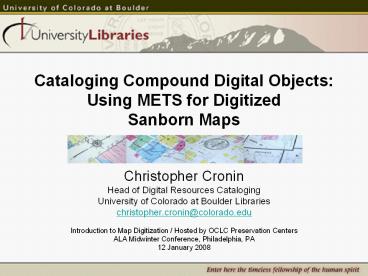Cataloging Compound Digital Objects: Using METS for Digitized Sanborn Maps PowerPoint PPT Presentation
1 / 10
Title: Cataloging Compound Digital Objects: Using METS for Digitized Sanborn Maps
1
Cataloging Compound Digital Objects Using METS
for Digitized Sanborn Maps
- Christopher Cronin
- Head of Digital Resources Cataloging
- University of Colorado at Boulder Libraries
- christopher.cronin_at_colorado.edu
- Introduction to Map Digitization / Hosted by OCLC
Preservation Centers - ALA Midwinter Conference, Philadelphia, PA
- 12 January 2008
2
What is METS Why Use it for Maps?
- Metadata Encoding Transmission Standard (METS)
- Maintained by Library of Congress
(http//www.loc.gov/standards/mets/) - Standardized and shareable
- Supports compound digital objects
- Hierarchical XML structure
- Supports repurposing of existing metadata
3
The Structure of a METS Record
- METS Header ltmetsHdrgt
- Structural Map ltstructMapgt
- Structural Links ltstructLinkgt
- File Section ltfileSecgt
- Descriptive Metadata ltdmdSecgt
- Administrative Metadata ltamdSecgt 4 types
- Technical Metadata
- Intellectual Property Rights Metadata
- Source Metadata
- Digital Provenance Metadata
- Behavior ltbehaviorSecgt
4
Descriptive Metadata
- Importance of presence in OCLC/WorldCat
- Separate-record approach
- Separate MARC records for analog and digital
versions in OCLC/WorldCat, local online catalog
(Chinook), digital library (DIAL), and the
regional union catalog (Prospector) - MarcEdit for MARC to MARCXML transformation
(http//oregonstate.edu/reeset/marcedit/html) - CU Generation Tool MARCXML to MODS
transformation (Metadata Object Description
Schema (http//www.loc.gov/standards/mods/)
5
Technical Metadata
- NISO Metadata for Images in XML (MIX)
- Technical Metadata for Digital Still Images
Standard - Maintained by the Library of Congress
(http//www.loc.gov/standards/mix//) - In-house digitization
- Programming skills to automatically capture the
technical data - Outsourcing digitization
- Importance of technical metadata in the RFP
and/or vendor selection process
6
CU Boulders METS/MODS Generation Tool (1)
- Availability of tools for METS record creation
- LCs list of METS tools and utilities
(http//www.loc.gov/standards/mets/mets-tools.html
) - Developing a local tool to fill the commercial
gap - CUs METS/MODS Generation Tool, and its technical
and user documentation, can be found at
(http//ucblibraries.colorado.edu/systems/digitali
nitiatives/tools.htm)
7
CU Boulders METS/MODS Generation Tool (2)
8
CU Boulders METS/MODS Generation Tool (3)
9
Strategic Planning for METS
- Institutional commitment
- Collaborative decision-making Map
Library/Public Services, Collection Managers,
Cataloging, Systems, and Administration - METS as part of long-term digital preservation
plan - PREMIS (Preservation Metadata Implementation
Strategies) (http//www.loc.gov/standards/premis/)
- Staffing requirements
- Metadata expertise, technical/programming skills,
knowledge of the collection - Systems requirements
- Capability for storing and/or serving out the
records
10
Additional Resources
- Cantara, L. (2005). METS the Metadata Encoding
and Transmission Standard. Cataloging
Classification Quarterly, vol. 40, no. 3/4, pp.
237-253. - Cundiff, M.V. (2004). An Introduction to the
Metadata Encoding and Transmission Standard
(METS). Library Hi Tech, vol. 22, no. 1, pp.
32-64. - Library of Congress. METS An Overview
Tutorial. http//www.loc.gov/standards/mets/METSOv
erview.v2.html

